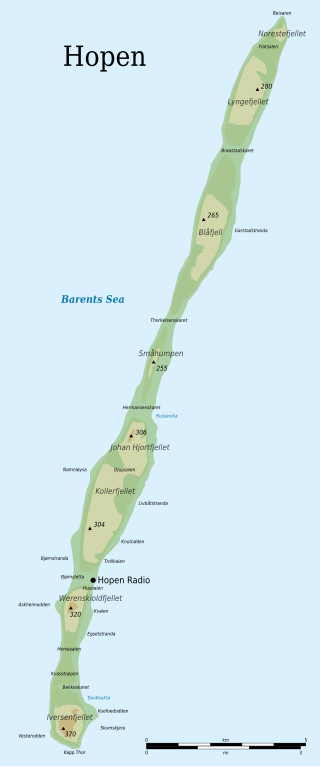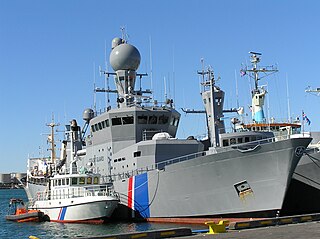
Jan Mayen is a Norwegian volcanic island in the Arctic Ocean with no permanent population. It is 55 km (34 mi) long (southwest-northeast) and 373 km2 (144 sq mi) in area, partly covered by glaciers. It has two parts: larger northeast Nord-Jan and smaller Sør-Jan, linked by a 2.5 km (1.6 mi) wide isthmus. It lies 600 km (370 mi) northeast of Iceland, 500 km (310 mi) east of central Greenland, and 900 km (560 mi) northwest of Vesterålen, Norway. The island is mountainous, the highest summit being the Beerenberg volcano in the north. The isthmus is the location of the two largest lakes of the island, Sørlaguna and Nordlaguna. A third lake is called Ullerenglaguna. Jan Mayen was formed by the Jan Mayen hotspot and is defined by geologists as a microcontinent.

Svalbard, previously known as Spitsbergen or Spitzbergen, is a Norwegian archipelago in the Arctic Ocean. North of mainland Europe, it lies about midway between the northern coast of Norway and the North Pole. The islands of the group range from 74° to 81° north latitude, and from 10° to 35° east longitude. The largest island is Spitsbergen, followed in size by Nordaustlandet and Edgeøya. The largest settlement is Longyearbyen on the west coast of Spitsbergen.

NoCGV Svalbard (W303) is a Norwegian Coast Guard icebreaker and offshore patrol vessel constructed by Langsten at Tangen Verft shipyard in Kragerø and launched on 17 February 2001. She was named 15 December 2001 in Tomrefjord with Minister of Defence Kristin Krohn Devold as godmother, and delivered to the Coast Guard on 18 January 2002. She entered service in mid-2002 and is homeported in Sortland. Her primary operating area is in the Arctic waters north of Norway, the Barents Sea and around the Svalbard islands.

Surcouf (F711) is a La Fayette-class frigate of the French Navy. Construction began at Lorient Naval Dockyard on 6 July 1992, launched 3 July 1993, and the ship was commissioned May 1996. Since entering service, Surcouf has taken part in numerous missions, notably in Operation Antilope, Operation Trident (Kosovo) and Mission Khor Anga in the Djibouti zone.

The Royal Norwegian Navy is the branch of the Norwegian Armed Forces responsible for naval operations of Norway, including those of the Norwegian Coast Guard. As of 2008, the Royal Norwegian Navy consists of approximately 3,700 personnel and 70 vessels, including 4 heavy frigates, 6 submarines, 14 patrol boats, 4 minesweepers, 4 minehunters, 1 mine detection vessel, 4 support vessels and 2 training vessels.

A patrol boat is a relatively small naval vessel generally designed for coastal defence, border security, or law enforcement. There are many designs for patrol boats, and they generally range in size. They may be operated by a nation's navy, coast guard, police, or customs, and may be intended for marine, estuarine, or river environments.
North Cape, Northern Cape, or Nordkapp may refer to:

Hopen is an island in the southeastern part of the Svalbard archipelago (Norway). Hopen was discovered in 1596 by Jan Cornelisz Rijp during the third expedition by Willem Barentsz, trying to find the Northeast Passage. Later, in 1613, its name was given by Thomas Marmaduke of Hull, who named it after his former command, the Hopewell.

The Nordkapp class is a Norwegian Coast Guard ship class built in the 1980s, and used for rescue, fishery inspection, research purposes and general EEZ patrol in Norwegian waters until the early 2020s. It is a class of ships purpose-built for the Norwegian Coast Guard with a secondary role as wartime naval escorts. The Norwegian Coast Guard is a part of the Royal Norwegian Navy, and has some police authority.
NoCGV Tromsø was a purpose-built, but leased, offshore patrol vessel for the Norwegian Coast Guard.

The Norwegian Coast Guard is a maritime military force which is part of the Royal Norwegian Navy. The coast guard's responsibility are for fisheries inspection, customs enforcement, border control, law enforcement, shipping inspection, environmental protection, and search and rescue. It operates throughout Norway's 2,385,178-square-kilometer (920,922 sq mi) exclusive economic zone (EEZ), internal waters and territorial waters. It is headquartered at Sortland Naval Base. In 2013 the Coast Guard had 370 employees, including conscripts, and a budget of 1.0 billion Norwegian krone.

NoCGV Barentshav is a large offshore patrol vessel of the Norwegian Coast Guard, and is their first liquefied natural gas-powered vessel. The contract was signed 21 October 2005, and NoCGV Barentshav was delivered in August 2009.
Thomas Marmaduke was an English explorer, sealer, and whaler in the early 17th century.

The Ægir-class offshore patrol vessel is a class of two offshore patrol vessels serving in the Icelandic Coast Guard (ICG). They participated in the two later Cod Wars. The vessels conduct patrols, search and rescue, fishery inspections, general law enforcement and counter-terrorism operations in the Icelandic exclusive economic zone and the waters of the surrounding territories, such as Greenland and Jan Mayen.

Harry DeWolf-class offshore patrol vessels are warships of the Royal Canadian Navy (RCN) built within the Government of Canada Arctic and Offshore Patrol Ship (AOPS) procurement project, part of the National Shipbuilding Strategy. In July 2007 the federal government announced plans for acquiring six to eight icebreaking warships for the RCN.

RV Kronprins Haakon is a Norwegian icebreaking polar research vessel owned by the Norwegian Polar Institute. The shiptime use is divided between the main users, the University of Tromsø (50%), Norwegian Polar Institute (30%) and Norwegian Institute of Marine Research (20%). She was built at Fincantieri shipyard in Genova, Italy, and delivered in 2018.

The Yarmook-class corvette is a class of corvettes in service with the Pakistan Navy. The class is primarily based on Damen Group's Offshore Patrol Vessel (OPV) 1900. The primary role of the class is to patrol the sea area.
The Type 212CD class is a submarine class developed by ThyssenKrupp Marine Systems (TKMS) for the Norwegian and German navies. The class is derived from the Type 212 submarine class, but will be significantly larger than the 212 class.















